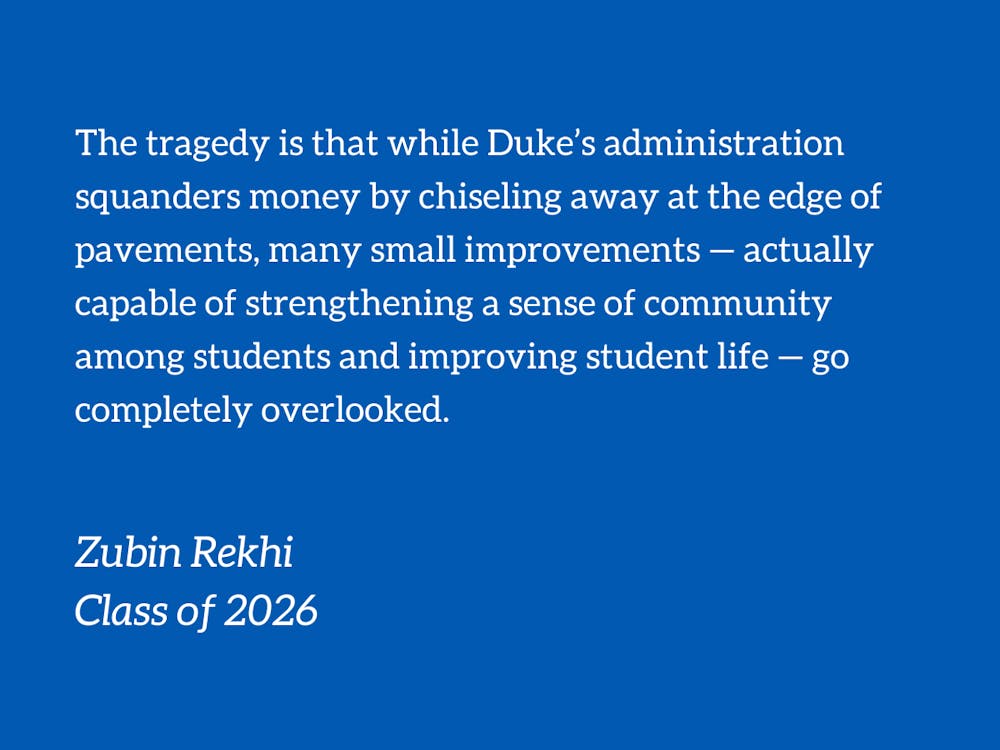If you've been asking yourself when construction and maintenance work is going to end on West Campus, it’s completely understandable. In my first two months on campus as a transfer student, I’ve had to learn and then relearn the ways to my classes not once but at least half a dozen times. I’ve become exhausted from attempting to find new foolproof ways to classes, the library, WU and the bus stop. I’ve even gotten lost in the Divinity School while finding a detour for traveling between my statistics class at the Levine Science Research Center and the library because the path I normally take through the breezeway was closed.
But my point in this article is not to complain about incessant repairs inconveniencing students. It is, instead, to argue that by prioritizing looks over function to the cost of students, the Duke administration’s repairs are counterproductive to achieving the goal of actually revitalizing Abele Quad as the heart of campus. Students need more places to hang out, not a fresh coat of fenced-off grass in Abele Quad.
The administration’s selfishness explains why the university’s vanity project takes precedence over fulfilling basic improvements to student life. It enables us to understand why tearing up a perfectly good plot of grass only to mulch and replant it again is higher up on the university’s priorities than increasing outdoor seating and benches on Abele Quad to actually bring students together. Student interest is irrelevant: here, what matters is optimizing picture frames for more clicks on a Duke website and impressing tour groups.
After reading through the list of projects planned for Duke’s Centennial, ]it becomes obvious that most “improvements” aren’t designed to improve student life; they serve purely aesthetic functions and provide no utility to students. And by polishing Abele further, the university makes it more unlikely that students will consider it a warm, communal space where they can spend time with their friends. The long-term projects that the university has invested in fulfilling include replacing bluestone walkways along Abele Quad and limestone steps to the Chapel, repaving the Chapel Drive bus circle, replacing concrete curbs with granite curbs on Chapel Drive, replacing the Chapel’s stained glass, strengthening the limestone arches along the breezeways, and repaving the tennis courts. The university also engages in constant landscape upkeep requiring planting, reseeding and repeatedly mowing plots of grass.
One wonders how many other projects directly addressing student needs the university could fulfill with the same funding instead of maintaining a laundry list of aesthetic improvements.
One also wonders whether these projects are worth inconveniencing students, faculty members, and campus visitors who just want to get from one point to another with as little trouble as possible. Replacing concrete curbs with granite ones is not at the top of any faculty member’s, visitor’s or student’s concerns. But having dust blown on their faces — from cut limestone and pulverized asphalt — and being late to commitments — from inconsistent access to walkways on West Campus — is surely on their list of irritations.
The tragedy is that while Duke’s administration squanders money by chiseling away at the edge of pavements, many small improvements — actually capable of strengthening a sense of community among students and improving student life — go completely overlooked. Lawn chairs, more benches, volleyball nets and hammocks could all bring the West Campus community together cost-effectively. It would be nice to see more students having picnics on Abele Quad and fewer stone walkways and perfectly manicured grass.
This is especially true because Abele, with its location at the center of campus, could actually contribute so much to student life. Currently, most students probably spend little time in and around Abele. BC Plaza is where students hang out in an outdoor space and where clubs hold tabling. WU and Pitchforks are where students eat, study, and discuss their days with their friends indoors. Perkins Library is where students hold study sessions. Considering that the administration justifies the repairs by calling Abele Quad the “heart of campus,” I find it ironic that I’d consider the outdoor quad to be one of the most dead places on campus. Turning Abele into the campus’s actual “heart” by installing outdoor seating and creating open spaces for students to picnic and discuss their days with their friends under sunlight would be the best renovation Duke could make to its campus. But clogging up the arteries used to access Abele and scattering fencing, industrial cranes and concrete only makes Abele even more useless to students.
I implore Duke’s administration to actually make good on its promise of revitalizing the “heart” of campus not by chiseling away at concrete curbs but by actually adding amenities that students would use on Abele.
Zubin Rekhi is a Trinity sophomore. His column typically runs on alternate Fridays.
Get The Chronicle straight to your inbox
Sign up for our weekly newsletter. Cancel at any time.

